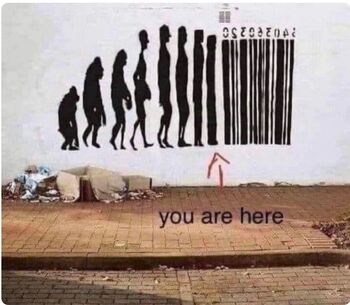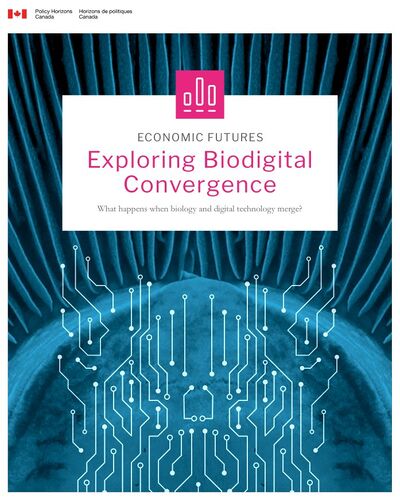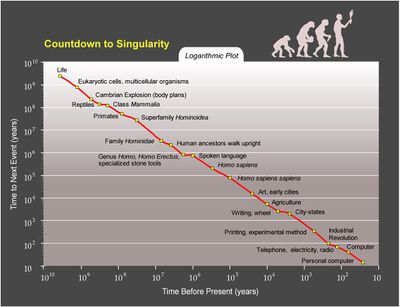Difference between revisions of "Transhumanism"
(cut bland stuff from Wikipedia) |
m (more bland stuff shaved off) |
||
| Line 124: | Line 124: | ||
In 2011, DARPA revealed plans to create an elite fighting force by creating software which could be uploaded directly to the brain to give their soldiers heightened senses<ref>https://www.express.co.uk/news/world/1005512/US-military-DARPA-super-soldiers-mysterious-experiments</ref> | In 2011, DARPA revealed plans to create an elite fighting force by creating software which could be uploaded directly to the brain to give their soldiers heightened senses<ref>https://www.express.co.uk/news/world/1005512/US-military-DARPA-super-soldiers-mysterious-experiments</ref> | ||
| − | DARPA is also working on triggering genes that will make soldiers' bodies able to convert fat into energy more efficiently so they are able to go days without eating while in the warzone. "Soldiers would be able to run at Olympic speeds, carry large weights and go without sleep and without food."<ref | + | DARPA is also working on triggering genes that will make soldiers' bodies able to convert fat into energy more efficiently so they are able to go days without eating while in the warzone. "Soldiers would be able to run at Olympic speeds, carry large weights and go without sleep and without food."<ref>https://www.dailymail.co.uk/sciencetech/article-2187276/U-S-Army-Soldiers-able-run-Olympic-speed-wont-need-food-sleep-gene-technology.html</ref> |
[[File:Exploring Biodigital Convergence.jpg|thumb|right|400px|The Government of [[Canada]] advertising the new possibilities of technology - <u>''Exploring Biodigital Convergence''</u>:<ref>http://web.archive.org/web/20200308031820/https://horizons.gc.ca/wp-content/uploads/2020/02/Biodigital-Convergence-with-Links-Final-02062020.pdf</ref><ref>http://archive.today/2021.05.24-025355/https://horizons.gc.ca/en/2020/02/11/exploring-biodigital-convergence/</ref> "New ways to change human beings – our bodies, minds, and behaviours", "Monitoring, altering and manipulating human thoughts and behaviours", "Neurotechnologies read brain signals to monitor attention and manage fatigue".]] | [[File:Exploring Biodigital Convergence.jpg|thumb|right|400px|The Government of [[Canada]] advertising the new possibilities of technology - <u>''Exploring Biodigital Convergence''</u>:<ref>http://web.archive.org/web/20200308031820/https://horizons.gc.ca/wp-content/uploads/2020/02/Biodigital-Convergence-with-Links-Final-02062020.pdf</ref><ref>http://archive.today/2021.05.24-025355/https://horizons.gc.ca/en/2020/02/11/exploring-biodigital-convergence/</ref> "New ways to change human beings – our bodies, minds, and behaviours", "Monitoring, altering and manipulating human thoughts and behaviours", "Neurotechnologies read brain signals to monitor attention and manage fatigue".]] | ||
| Line 148: | Line 148: | ||
In his 2003 book ''Enough: Staying Human in an Engineered Age'', [[environmental ethics|environmental ethicist]] [[Bill McKibben]] argued at length against many of the technologies that are postulated or supported by transhumanists, including [[germinal choice technology]], [[nanomedicine]] and [[life extension]] strategies. He claims that it would be morally wrong for humans to tamper with fundamental aspects of themselves (or their children) in an attempt to overcome universal human limitations, such as vulnerability to [[aging]], [[maximum life span]] and biological constraints on physical and cognitive ability. Attempts to "improve" themselves through such manipulation would remove limitations that provide a necessary context for the experience of meaningful human choice. He claims that human lives would no longer seem [[Meaning of life|meaningful]] in a world where such limitations could be overcome technologically. Even the goal of using germinal choice technology for clearly therapeutic purposes should be relinquished, since it would inevitably produce temptations to tamper with such things as cognitive capacities. He argues that it is possible for societies to benefit from renouncing particular technologies, using as examples [[Ming Dynasty|Ming China]], [[Tokugawa shogunate|Tokugawa Japan]] and the contemporary [[Amish]].<ref>name="McKibben 2003"</ref> | In his 2003 book ''Enough: Staying Human in an Engineered Age'', [[environmental ethics|environmental ethicist]] [[Bill McKibben]] argued at length against many of the technologies that are postulated or supported by transhumanists, including [[germinal choice technology]], [[nanomedicine]] and [[life extension]] strategies. He claims that it would be morally wrong for humans to tamper with fundamental aspects of themselves (or their children) in an attempt to overcome universal human limitations, such as vulnerability to [[aging]], [[maximum life span]] and biological constraints on physical and cognitive ability. Attempts to "improve" themselves through such manipulation would remove limitations that provide a necessary context for the experience of meaningful human choice. He claims that human lives would no longer seem [[Meaning of life|meaningful]] in a world where such limitations could be overcome technologically. Even the goal of using germinal choice technology for clearly therapeutic purposes should be relinquished, since it would inevitably produce temptations to tamper with such things as cognitive capacities. He argues that it is possible for societies to benefit from renouncing particular technologies, using as examples [[Ming Dynasty|Ming China]], [[Tokugawa shogunate|Tokugawa Japan]] and the contemporary [[Amish]].<ref>name="McKibben 2003"</ref> | ||
| − | |||
| − | |||
===Genetic divide === | ===Genetic divide === | ||
| Line 157: | Line 155: | ||
Even [[Lee M. Silver]], the biologist and [[science writer]] who coined the term "[[reprogenetics]]" and supports its applications, has expressed concern that these methods could create a two-tiered society of genetically engineered "haves" and "have nots" if social democratic reforms lag behind implementation of enhancement technologies.<ref>name="Silver 1998"</ref> The [[1997]] film ''[[Gattaca]]'' depicts a [[dystopia]]n society in which one's [[social class]] depends entirely on genetic potential and is often cited by critics in support of these views.<ref>https://en.wikipedia.org/wiki/Citizen_Cyborg</ref> | Even [[Lee M. Silver]], the biologist and [[science writer]] who coined the term "[[reprogenetics]]" and supports its applications, has expressed concern that these methods could create a two-tiered society of genetically engineered "haves" and "have nots" if social democratic reforms lag behind implementation of enhancement technologies.<ref>name="Silver 1998"</ref> The [[1997]] film ''[[Gattaca]]'' depicts a [[dystopia]]n society in which one's [[social class]] depends entirely on genetic potential and is often cited by critics in support of these views.<ref>https://en.wikipedia.org/wiki/Citizen_Cyborg</ref> | ||
| − | |||
| − | |||
=== Specter of coercive eugenicism === | === Specter of coercive eugenicism === | ||
Some critics of transhumanism see the old [[eugenics]], [[social Darwinist]], and [[master race]] ideologies and programs of the past as warnings of what the promotion of eugenic enhancement technologies might unintentionally encourage. Some fear future "[[Biopolitics|eugenics wars]]" as the worst-case scenario: the return of coercive state-sponsored [[genetic discrimination]] and [[Human rights violations#Human rights violations|human rights violations]] such as [[compulsory sterilization]] of persons with genetic defects, the killing of the institutionalized and, specifically, [[racial segregation|segregation]] and [[genocide]] of [[Social interpretations of race|''races'']]'' ''perceived as inferior.<ref>name="Black 2003"</ref> Health law professor [[George Annas]] and technology law professor [[Lori Andrews]] are prominent advocates of the position that the use of these technologies could lead to such human-[[posthuman]] [[caste]] warfare.<ref>name="Darnovsky Crossroads"</ref><ref>name="Annas 2002"</ref> | Some critics of transhumanism see the old [[eugenics]], [[social Darwinist]], and [[master race]] ideologies and programs of the past as warnings of what the promotion of eugenic enhancement technologies might unintentionally encourage. Some fear future "[[Biopolitics|eugenics wars]]" as the worst-case scenario: the return of coercive state-sponsored [[genetic discrimination]] and [[Human rights violations#Human rights violations|human rights violations]] such as [[compulsory sterilization]] of persons with genetic defects, the killing of the institutionalized and, specifically, [[racial segregation|segregation]] and [[genocide]] of [[Social interpretations of race|''races'']]'' ''perceived as inferior.<ref>name="Black 2003"</ref> Health law professor [[George Annas]] and technology law professor [[Lori Andrews]] are prominent advocates of the position that the use of these technologies could lead to such human-[[posthuman]] [[caste]] warfare.<ref>name="Darnovsky Crossroads"</ref><ref>name="Annas 2002"</ref> | ||
| − | |||
| − | |||
=== Existential risks === | === Existential risks === | ||
In his 2003 book ''[[Our Final Hour]]'', British [[Astronomer Royal]] [[Martin Rees]] argues that advanced science and technology bring as much risk of disaster as opportunity for progress. However, Rees does not advocate a halt to scientific activity. Instead, he calls for tighter security and perhaps an end to traditional scientific openness.<ref>name="Rees 2003"</ref> Advocates of the [[precautionary principle]], such as many in the [[environmental movement]], also favor slow, careful progress or a halt in potentially dangerous areas. Some precautionists believe that [[artificial intelligence]] and [[robotics]] present possibilities of alternative forms of cognition that may threaten human life.<ref>name="Arnall 2003"</ref> | In his 2003 book ''[[Our Final Hour]]'', British [[Astronomer Royal]] [[Martin Rees]] argues that advanced science and technology bring as much risk of disaster as opportunity for progress. However, Rees does not advocate a halt to scientific activity. Instead, he calls for tighter security and perhaps an end to traditional scientific openness.<ref>name="Rees 2003"</ref> Advocates of the [[precautionary principle]], such as many in the [[environmental movement]], also favor slow, careful progress or a halt in potentially dangerous areas. Some precautionists believe that [[artificial intelligence]] and [[robotics]] present possibilities of alternative forms of cognition that may threaten human life.<ref>name="Arnall 2003"</ref> | ||
| − | [[Nick Bostrom]] argues that even barring the occurrence of a singular [[Global catastrophic risk|global catastrophic event]], basic [[Malthusian]] and evolutionary forces facilitated by technological progress threaten to eliminate the positive aspects of human society.<ref | + | [[Nick Bostrom]] argues that even barring the occurrence of a singular [[Global catastrophic risk|global catastrophic event]], basic [[Malthusian]] and evolutionary forces facilitated by technological progress threaten to eliminate the positive aspects of human society.<ref name="bostrom-evolution">http://www.nickbostrom.com/fut/evolution.html</ref> |
One transhumanist solution proposed by Bostrom to counter existential risks is control of [[differential technological development]], a series of attempts to influence the sequence in which technologies are developed. In this approach, planners would strive to retard the development of possibly harmful technologies and their applications, while accelerating the development of likely beneficial technologies, especially those that offer protection against the harmful effects of others.<ref>name="Bostrom 2002"</ref> | One transhumanist solution proposed by Bostrom to counter existential risks is control of [[differential technological development]], a series of attempts to influence the sequence in which technologies are developed. In this approach, planners would strive to retard the development of possibly harmful technologies and their applications, while accelerating the development of likely beneficial technologies, especially those that offer protection against the harmful effects of others.<ref>name="Bostrom 2002"</ref> | ||
Revision as of 13:52, 7 January 2022
 | |
| Interest of | • "Smart city" • Jacques Attali • Berggruen Institute • Nicolas Berggruen • Nick Bostrom • Jeffrey Epstein • Yuval Harari • Ray Kurzweil • Stéphanie Lacour • Elon Musk • Larry Page • SDS • The Great Reset • Peter Thiel • Carlo Maria Viganò • Luhan Yang |
| Superhuman concept with large billionaire following | |
Transhumanism is a philosophical movement that advocates for the transformation of the human species by developing and making widely available sophisticated technologies able to greatly modify or enhance human intellect and physiology.[1][2] The most common transhumanist thesis is that human beings may eventually be able to transform themselves into different beings with abilities so greatly expanded from the current condition as to merit the label of posthuman beings.[3].
The idea has a significant following among the global super-class of billionaires and their political proteges. With their vast resources and awareness of their own mortality and frail, aging bodies, the idea of living forever with augmented capabilities by hybridizing a genetically improved human body with artificially intelligent robots and the Internet, thereby creating a new breed of superior humans called ‘Transhumans’, has great appeal.
Trans-humanistic fantasies often describes, lightly disguised as an ethical dilemma, this new breed of supermen lording over common mortals, to the extent that they still will exist. The idea often ties in with eugenics and a large reduction in world population.
The big tech companies are pushing variants of the idea. Google has even hired their own in-house transhumanist, Ray Kurzweil.
“The 4th Industrial Revolution will lead to a fusion of our physical, our digital and our biological identities.”
Claus Schwab [4]
Contents
History
Precursors of transhumanism
According to Nick Bostrom, transcendentalist impulses have been expressed at least as far back as the quest for immortality in the Epic of Gilgamesh, as well as in historical quests for the Fountain of Youth, the Elixir of Life, and other efforts to stave off aging and death.[5]
There is debate about whether the philosophy of Friedrich Nietzsche can be considered an influence on transhumanism, despite its exaltation of the "Übermensch" (overman or superman), due to its emphasis on self-actualization rather than technological transformation.[6][7][8][9] The transhumanist philosophies of Max More and Stefan Lorenz Sorgner have been influenced strongly by Nietzschean thinking.[10] By way of contrast, The Transhumanist Declaration[11] "...advocates the well-being of all sentience (whether in artificial intellects, humans, posthumans, or non-human animals)".
Transhumanism and Eugenics

Fundamental ideas of transhumanism were first advanced in 1923 by the British geneticist J. B. S. Haldane in his essay Daedalus: Science and the Future, which predicted that great benefits would come from the application of advanced sciences to human biology—and that every such advance would first appear to someone as blasphemy or perversion, "indecent and unnatural". In particular, he was interested in the development of the science of eugenics, ectogenesis (creating and sustaining life in an artificial environment), and the application of genetics to improve human characteristics, such as health and intelligence.
The biologist Julian Huxley is generally regarded as the founder of transhumanism after using the term for the title of an influential 1957 article, where he defined it as "the human species can, if it wishes, transcend itself—not just sporadically, an individual here in one way, an individual there in another way, but in its entirety, as humanity."[12]
Huxley invented the term “transhumanism” just before he became President of the British Eugenics Society[13], 1959-62. Huxley was also the first Director General of UNESCO.
Huxley had similar preoccupations his entire career:
“unless [civilised societies] invent and enforce adequate measures for regulating human reproduction, for controlling the quantity of population, and at least preventing the deterioration of quality of racial stock, they are doomed to decay”
Julian Huxley (1926) [citation needed]
Artificial intelligence and the technological singularity
The concept of the technological singularity, or the ultra-rapid advent of superhuman intelligence, was first proposed by the British cryptologist I. J. Good in 1965:
Let an ultraintelligent machine be defined as a machine that can far surpass all the intellectual activities of any man however clever. Since the design of machines is one of these intellectual activities, an ultraintelligent machine could design even better machines; there would then unquestionably be an 'intelligence explosion,' and the intelligence of man would be left far behind. Thus the first ultraintelligent machine is the last invention that man need ever make.[14]
Computer scientist Marvin Minsky wrote on relationships between human and artificial intelligence beginning in the 1960s.[15] Over the succeeding decades, this field continued to generate influential thinkers such as Hans Moravec and Raymond Kurzweil, who oscillated between the technical arena and futuristic speculations in the transhumanist vein.[16][17] The coalescence of an identifiable transhumanist movement began in the last decades of the 20th century. In 1966, FM-2030 (formerly F. M. Esfandiary), a futurist who taught "new concepts of the human" at The New School, in New York City, began to identify people who adopt technologies, lifestyles and world views transitional to posthumanity as "transhuman".[18] In 1972, Robert Ettinger, whose 1964 Prospect of Immortality founded the cryonics movement,[19] contributed to the conceptualization of "transhumanity" with his 1972 Man into Superman.[20] FM-2030 published the Upwingers Manifesto in 1973.[21]
Theory
A common feature of transhumanism and philosophical posthumanism is the future vision of a new intelligent species, into which humanity will evolve and eventually will supplement or supersede it. Transhumanism stresses the evolutionary perspective, including sometimes the creation of a highly intelligent animal species by way of cognitive enhancement (i.e. biological uplift),[22] but clings to a "posthuman future" as the final goal of participant evolution.[23]
“Even if half the world’s species were lost [during genetic experiments], enormous diversity would still remain. When those in the distant future look back on this period of history, they will likely see it not as the era when the natural environment was impoverished, but as the age when a plethora of new forms—some biological, some technological, some a combination of the two—burst onto the scene. We best serve ourselves, as well as future generations, by focusing on the short-term consequences of our actions rather than our vague notions about the needs of the distant future.”
Gregory Stock (1993) [24]
Stock is former director of the program in Medicine, Technology, and Society at the UCLA School of Medicine
Aims
You awake one morning to find your brain has another lobe functioning. Invisible, this auxiliary lobe answers your questions with information beyond the realm of your own memory, suggests plausible courses of action, and asks questions that help bring out relevant facts. You quickly come to rely on the new lobe so much that you stop wondering how it works. You just use it. This is the dream of artificial intelligence.
While many transhumanist theorists and advocates seek to apply reason, science and technology for the purposes of reducing poverty, disease, disability and malnutrition around the globe,[25] transhumanism is distinctive in its particular focus on the applications of technologies to the improvement of human bodies at the individual level.
Transhumanist philosophers argue that there not only exists a perfectionist ethical imperative for humans to strive for progress and improvement of the human condition, but that it is possible and desirable for humanity to enter a transhuman phase of existence in which humans enhance themselves beyond what is naturally human. In such a phase, natural evolution would be replaced with deliberate participatory or directed evolution.
Some theorists such as Ray Kurzweil think that the pace of technological innovation is accelerating and that the next 50 years may yield not only radical technological advances, but possibly a technological singularity, which may fundamentally change the nature of human beings.[26]
Man and Superman
Unlike many philosophers, social critics and activists who place a moral value on preservation of natural systems, transhumanists see the very concept of the specifically natural as problematically nebulous at best and an obstacle to progress at worst.[27] In keeping with this, many prominent transhumanist advocates, such as Dan Agin, refer to transhumanism's critics, on the political right and left jointly, as "bioconservatives" or "bioluddites", the latter term alluding to the 19th century anti-industrialisation social movement that opposed the replacement of human manual labourers by machines.[28]
There are many who fear that the improvements afforded by a specific, privileged section of society will lead to a division of the human species into two different and distinct species.[29] The idea of two human species, one being at a great physical and economic advantage in comparison with the other, is a troublesome one at best. One may be incapable of breeding with the other, and may by consequence of lower physical health and ability, be considered of a lower moral standing than the other.
“The GenRich—who account for ten percent of the American population—[will] all carry synthetic genes. All aspects of the economy, the media, the entertainment industry, and the knowledge industry are controlled by members of the GenRich class…
“Naturals [unaltered humans] work as low-paid service providers or as laborers. [Eventually] the GenRich class and the Natural class will become entirely separate species with no ability to crossbreed, and with as much romantic interest in each other as a current human would have for a chimpanzee.
“Many think that it is inherently unfair for some people to have access to technologies that can provide advantages while others, less well-off, are forced to depend on chance alone, [but] American society adheres to the principle that personal liberty and personal fortune are the primary determinants of what individuals are allowed and able to do.
“Indeed, in a society that values individual freedom above all else, it is hard to find any legitimate basis for restricting the use of repro[grammed]-genetics. I will argue [that] the use of reprogenetic technologies is inevitable. [W]hether we like it or not, the global marketplace will reign supreme.”
Lee Silver (1998) [30]
Lee Silver is a molecular biologist at Princeton University
Technologies of interest
| James Corbett made a documentary abut it (also at https://www.bitchute.com/video/INC5y4lZTlE) |
Transhumanists support the emergence and convergence of technologies including nanotechnology, biotechnology, information technology and cognitive science (NBIC), as well as hypothetical future technologies like simulated reality, artificial intelligence, superintelligence, 3D bioprinting, mind uploading, chemical brain preservation and cryonics. They believe that humans can and should use these technologies to become more than human.[31] Therefore, they support the recognition and/or protection of cognitive liberty, morphological freedom and procreative liberty as civil liberties, so as to guarantee individuals the choice of using human enhancement technologies on themselves and their children.[32] Some speculate that human enhancement techniques and other emerging technologies may facilitate more radical human enhancement no later than at the midpoint of the 21st century. Kurzweil's book The Singularity is Near and Michio Kaku's book Physics of the Future outline various human enhancement technologies and give insight on how these technologies may impact the human race.[33][34]
Neuroscientist Anders Sandberg has been practicing on the method of scanning ultra-thin sections of the brain. This method is being used to help better understand the architecture of the brain. As of now, this method is currently being used on mice. This is the first step towards hypothetically uploading contents of the human brain, including memories and emotions, onto a computer.[35]
Military Research
Especially the US military has shown extensive interest in transhumanistic technologies:
DARPA, the US Department of Defense's research arm, is paying scientists to invent ways to instantly read soldiers' minds using tools like genetic engineering of the human brain, nanotechnology and infrared beams.[36]
In 2019, six teams received funding under the Next-Generation Nonsurgical Neurotechnology (N3) program, tasked with developing technology that will provide a two-way channel for rapid and seamless communication between the human brain and machines without requiring surgery.
Jacob Robinson, an assistant professor of bioengineering at Rice University, who is leading one of the teams, plans to use viruses modified to deliver genetic material into cells — called viral vectors — to insert DNA into specific neurons that will make them produce two kinds of proteins.
The first type of protein absorbs light when a neuron is firing, which makes it possible to detect neural activity. Because of the protein, the targeted areas will appear darker (absorbing light) when neurons are firing, generating a read of brain activity that can be used by a headset to work out what the person is seeing, hearing or trying to do.
The second protein tethers to magnetic nanoparticles, so the neurons can be magnetically stimulated to fire when the headset generates a magnetic field. This could be used to stimulate neurons so as to induce an image or sound in the patient's mind.
In 2011, DARPA revealed plans to create an elite fighting force by creating software which could be uploaded directly to the brain to give their soldiers heightened senses[37]
DARPA is also working on triggering genes that will make soldiers' bodies able to convert fat into energy more efficiently so they are able to go days without eating while in the warzone. "Soldiers would be able to run at Olympic speeds, carry large weights and go without sleep and without food."[38]

Practice
While some transhumanists take an abstract and theoretical approach to the perceived benefits of emerging technologies, others have offered specific proposals for modifications to the human body, including heritable ones. Transhumanists are often concerned with methods of enhancing the human nervous system. Though some, such as Kevin Warwick, propose modification of the peripheral nervous system, the brain is considered the common denominator of personhood and is thus a primary focus of transhumanist ambitions.[41]

As proponents of self-improvement and body modification, transhumanists tend to use existing technologies and techniques that supposedly improve cognitive and physical performance, while engaging in routines and lifestyles designed to improve health and longevity.[42] Depending on their age, some transhumanists express concern that they will not live to reap the benefits of future technologies. However, many have a great interest in life extension strategies and in funding research in cryonics in order to make the latter a viable option of last resort, rather than remaining an unproven method.[43]
“I'm looking into parabiosis stuff, which I think is really interesting. This is where they did the young blood into older mice and they found that had a massive rejuvenating effect,” he said. “And so that’s . . . that is one that . . . again, it’s one of these very odd things where people had done these studies in the 1950s and then it got dropped altogether. I think there are a lot of these things that have been strangely under-explored.”
Peter Thiel [44]
Allegedly, Thiel “spends $40,000 per quarter to get an infusion of blood from an 18-year-old"
Other transhumanists, such as cyborg artist Neil Harbisson, use technologies and techniques to improve their senses and perception of reality. Harbisson's antenna, which is permanently implanted in his skull, allows him to sense colours beyond human perception such as infrareds and ultraviolets.[45]
Feasibility
Although generally sympathetic to transhumanism, public health professor Gregory Stock is skeptical of the technical feasibility and mass appeal of the cyborgization of humanity predicted by Raymond Kurzweil, Hans Moravec and Kevin Warwick. He said that, throughout the 21st century, many humans would find themselves deeply integrated into systems of machines, but would remain biological. Primary changes to their own form and character would arise not from cyberware, but from the direct manipulation of their genetics, metabolism and biochemistry.[46]
Loss of human identity

In his 2003 book Enough: Staying Human in an Engineered Age, environmental ethicist Bill McKibben argued at length against many of the technologies that are postulated or supported by transhumanists, including germinal choice technology, nanomedicine and life extension strategies. He claims that it would be morally wrong for humans to tamper with fundamental aspects of themselves (or their children) in an attempt to overcome universal human limitations, such as vulnerability to aging, maximum life span and biological constraints on physical and cognitive ability. Attempts to "improve" themselves through such manipulation would remove limitations that provide a necessary context for the experience of meaningful human choice. He claims that human lives would no longer seem meaningful in a world where such limitations could be overcome technologically. Even the goal of using germinal choice technology for clearly therapeutic purposes should be relinquished, since it would inevitably produce temptations to tamper with such things as cognitive capacities. He argues that it is possible for societies to benefit from renouncing particular technologies, using as examples Ming China, Tokugawa Japan and the contemporary Amish.[48]
Genetic divide
Some critics of libertarian transhumanism have focused on the likely socioeconomic consequences in societies in which divisions between rich and poor are on the rise. Bill McKibben, for example, suggests that emerging human enhancement technologies would be disproportionately available to those with greater financial resources, thereby exacerbating the gap between rich and poor and creating a "genetic divide".[49]
This was also the topic of the The Bravo Evolution Report, a sci-f essay by Oliver Curry in 2006.
Even Lee M. Silver, the biologist and science writer who coined the term "reprogenetics" and supports its applications, has expressed concern that these methods could create a two-tiered society of genetically engineered "haves" and "have nots" if social democratic reforms lag behind implementation of enhancement technologies.[50] The 1997 film Gattaca depicts a dystopian society in which one's social class depends entirely on genetic potential and is often cited by critics in support of these views.[51]
Specter of coercive eugenicism
Some critics of transhumanism see the old eugenics, social Darwinist, and master race ideologies and programs of the past as warnings of what the promotion of eugenic enhancement technologies might unintentionally encourage. Some fear future "eugenics wars" as the worst-case scenario: the return of coercive state-sponsored genetic discrimination and human rights violations such as compulsory sterilization of persons with genetic defects, the killing of the institutionalized and, specifically, segregation and genocide of races perceived as inferior.[52] Health law professor George Annas and technology law professor Lori Andrews are prominent advocates of the position that the use of these technologies could lead to such human-posthuman caste warfare.[53][54]
Existential risks
In his 2003 book Our Final Hour, British Astronomer Royal Martin Rees argues that advanced science and technology bring as much risk of disaster as opportunity for progress. However, Rees does not advocate a halt to scientific activity. Instead, he calls for tighter security and perhaps an end to traditional scientific openness.[55] Advocates of the precautionary principle, such as many in the environmental movement, also favor slow, careful progress or a halt in potentially dangerous areas. Some precautionists believe that artificial intelligence and robotics present possibilities of alternative forms of cognition that may threaten human life.[56]
Nick Bostrom argues that even barring the occurrence of a singular global catastrophic event, basic Malthusian and evolutionary forces facilitated by technological progress threaten to eliminate the positive aspects of human society.[57]
One transhumanist solution proposed by Bostrom to counter existential risks is control of differential technological development, a series of attempts to influence the sequence in which technologies are developed. In this approach, planners would strive to retard the development of possibly harmful technologies and their applications, while accelerating the development of likely beneficial technologies, especially those that offer protection against the harmful effects of others.[58]
External links
- Bitchute - Interview withDavid Livingstone - What is Transhumanism? Fascism? Cult? Religion? Super-Human DNA? David Livingstone Tony Gosling
Examples
| Page name | Description |
|---|---|
| Cyborg | Combination of biological and artificial organism |
| Optogenetics | A biological technique that involves the use of light to control neurons;A Virtual Reality System for Controlling Living Cells |
Related Quotations
| Page | Quote | Author | Date |
|---|---|---|---|
| Ray Kurzweil | “Our thinking then will be a hybrid of biological and non-biological thinking. We’ll be able to extend our limitations and think in the cloud. We’re going to put gateways to the cloud in our brains...We’re going to gradually merge and enhance ourselves. In my view, that’s the nature of being human – we transcend our limitations.” | Ray Kurzweil | 2015 |
| Elon Musk | “Under any rate of advancement in AI we will be left behind by a lot. The benign situation with ultra-intelligent AI is that we would be so far below in intelligence we’d be like a pet, or a house cat. I don’t love the idea of being a house cat. The solution that seems maybe the best one is to have an AI layer. A third digital layer that could work symbiotically [with your brain].” | Elon Musk | 2016 |
| Peter Thiel | “I'm looking into parabiosis stuff, which I think is really interesting. This is where they did the young blood into older mice and they found that had a massive rejuvenating effect," he said. "And so that's... that is one that... again, it's one of these very odd things where people had done these studies in the 1950s and then it got dropped altogether. I think there are a lot of these things that have been strangely under-explored.” | Peter Thiel |
References
- ↑ Mercer, Calvin. Religion and Transhumanism: The Unknown Future of Human Enhancement. Praeger.
- ↑ Bostrom, Nick (2005) http://www.nickbostrom.com/papers/history.pdf
- ↑ Bostrom, Nick (2005) http://www.nickbostrom.com/papers/history.pdf
- ↑ https://www.bitchute.com/video/I3tNprwfNfwP/
- ↑ Bostrom, Nick (2005) http://www.nickbostrom.com/papers/history.pdf
- ↑ Bostrom, Nick (2005) http://www.nickbostrom.com/papers/history.pdf
- ↑ http://jetpress.org/v20/sorgner.htm
- ↑ name="Blackford 2010"
- ↑ name="Sorgner 2012"
- ↑ http://jetpress.org/v20/sorgner.htm
- ↑ https://web.archive.org/web/20060910010545/http://www.transhumanism.org/index.php/WTA/faq21/79/
- ↑ https://web.archive.org/web/20160625132722/http://www.transhumanism.org/index.php/WTA/more/huxley
- ↑ https://www.hli.org/resources/history-of-eugenics-movement/
- ↑ https://web.archive.org/web/20090420061605/http://www.aeiveos.com/~bradbury/Authors/Computing/Good-IJ/SCtFUM.html "Speculations Concerning the First Ultraintelligent Machine"
- ↑ http://web.media.mit.edu/~minsky/papers/steps.html
- ↑ name="Moravec 1998"
- ↑ name="Kurzweil 1999"
- ↑ https://archive.org/details/areyoutranshuman00fm20
- ↑ https://www.theguardian.com/science/2016/nov/18/the-cryonics-dilemma-will-deep-frozen-bodies-be-fit-for-new-life
- ↑ name="Ettinger 1972"
- ↑ name="FM-2030 1973"
- ↑ https://en.wikipedia.org/wiki/Citizen_Cyborg
- ↑ name="Bostrom 2006">cite web | last = Bostrom | first = Nick | title = Why I Want to be a Posthuman When I Grow Up | url = http://www.nickbostrom.com/posthuman.pdf | access-date = December 10, 2007
- ↑ http://lobby.la.psu.edu/_107th/121_Human_Cloning/Organizational_Statements/CGS/CGS_Quiet_Campaign_01.htm Orignally from his book "Metaman: The Merging of Humans and Machines into a Global Superorganism."
- ↑ name="What is Transhumanism"
- ↑ name="Kurzweil 2005"
- ↑ http://www.nickbostrom.com/evolution.pdf
- ↑ http://www.changesurfer.com/Acad/TranshumPolitics.htm
- ↑ name=":0">Cite journal|jstor=27719694|doi=10.1136/jme.2005.013789|pmid=16943331|pmc=2563415
- ↑ https://reader.exacteditions.com/issues/49426/page/10
- ↑ name="Naam 2005"
- ↑ name="Sandberg 2001"
- ↑ name="Kurzweil 2005"
- ↑ cite book|last=Kaku|first=Michio|title=Physics of the Future|year=2011|publisher=Doubleday|location=United States|page=389
- ↑ http://www.fhi.ox.ac.uk/Reports/2008-3.pdf
- ↑ https://www.livescience.com/65546-darpa-mind-controlled-weapons.html
- ↑ https://www.express.co.uk/news/world/1005512/US-military-DARPA-super-soldiers-mysterious-experiments
- ↑ https://www.dailymail.co.uk/sciencetech/article-2187276/U-S-Army-Soldiers-able-run-Olympic-speed-wont-need-food-sleep-gene-technology.html
- ↑ http://web.archive.org/web/20200308031820/https://horizons.gc.ca/wp-content/uploads/2020/02/Biodigital-Convergence-with-Links-Final-02062020.pdf
- ↑ http://archive.today/2021.05.24-025355/https://horizons.gc.ca/en/2020/02/11/exploring-biodigital-convergence/
- ↑ name="Walker 2002"
- ↑ name="Kurzweil 1993"
- ↑ name="Kurzweil 2004"
- ↑ https://www.vanityfair.com/news/2016/08/peter-thiel-wants-to-inject-himself-with-young-peoples-blood
- ↑ Adams, Tim "When man meets metal: rise of the transhumans", The Guardian, 29 October 2017
- ↑ name="Stock 2002"
- ↑ name="Alexander 2000"
- ↑ name="McKibben 2003"
- ↑ name="McKibben 2003"
- ↑ name="Silver 1998"
- ↑ https://en.wikipedia.org/wiki/Citizen_Cyborg
- ↑ name="Black 2003"
- ↑ name="Darnovsky Crossroads"
- ↑ name="Annas 2002"
- ↑ name="Rees 2003"
- ↑ name="Arnall 2003"
- ↑ http://www.nickbostrom.com/fut/evolution.html
- ↑ name="Bostrom 2002"
Wikipedia is not affiliated with Wikispooks. Original page source here

